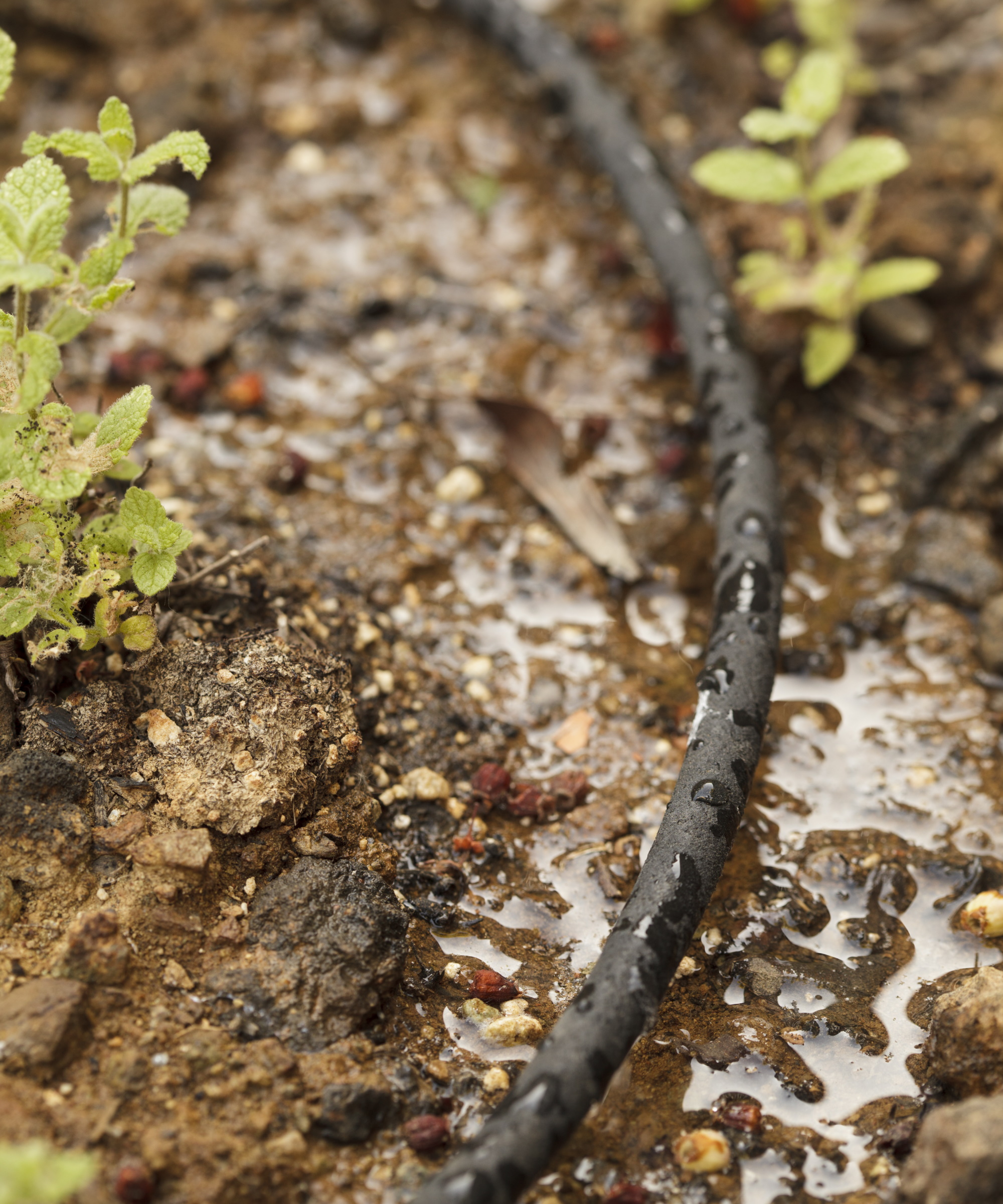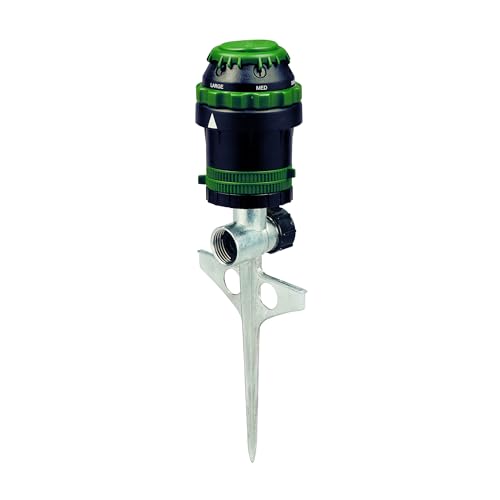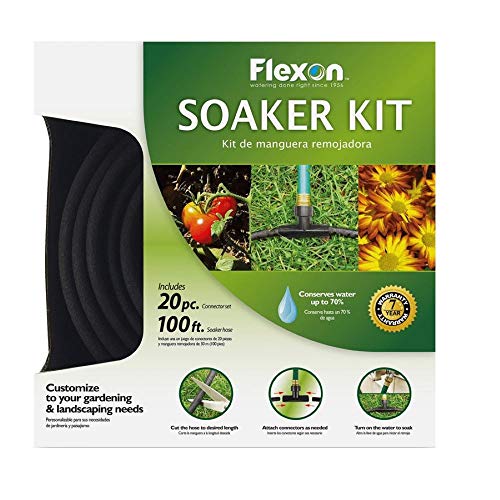Sprinkler vs soaker hose – which is the best choice for watering your yard?
The lowdown on the pros and cons, and in what situations they excel

Drew Swainston

When it comes to sprinkler vs soaker hose, both are great ways to water, but what’s the difference? And which one do you need when it comes to irrigating your backyard?
Choosing the best option for a lawn, border, or vegetable garden means you need to know how both a sprinkler and a soaker hose work and, therefore, whether you need one or the other – or perhaps both – for watering plants and keeping the entire yard growing well.
To help make it easier for you to decide what is best, here is our guide to the similarities and differences of sprinklers and soaker hoses - along with how to choose between the two.

Is a sprinkler or a soaker hose better for my garden?
To know which is better, you need to know how they work and what they’re designed to do best. We gather some expert opinions on sprinkler vs soaker hose from irrigation and gardens professionals.
Why use a sprinkler system?

Advantages:
- Ideal for watering large areas
- Ideal for delicate plants
- Choices available for watering method and distance
Disadvantages:
- Can waste water
- Uneven watering
- Wet foliage increases risk of disease
A sprinkler attaches to a garden hose which is, in turn, attached to a faucet, or it is attached to underground pipes in an irrigation system. The water emerges from small holes in the sprinkler head.
Design expertise in your inbox – from inspiring decorating ideas and beautiful celebrity homes to practical gardening advice and shopping round-ups.
There are different kinds of sprinkler heads to choose from. Garden sprinklers with a spray head produce a constant stream of water in a fixed area. Alternatively, a rotor sprinkler irrigates by moving in circles or part circles - covering a wider area than a spray head does. The distance a sprinkler covers varies according to the model, so you can select to suit your yard’s dimensions.
‘A sprinkler is ideal for watering large areas of your garden, like the lawn or a flower bed,’ explains Melody Estes, a landscape design gardening supervisor from Maine and a consultant at The Project Girl.
‘They’re good for watering long grass and flowers that need a lot of water to stay healthy. They can also help when it comes to watering plants while you're away from home for a few days or more.’
Sprinklers are also ideal for sensitive plants that require a finer spray, however, there are potential downsides to using them. That includes having to use them at the right time of day to avoid losing lots of water to evaporation.
Jeremy Yamaguchi, CEO of Lawn Love, adds that ‘sometimes you can’t get sprinklers to water all of the places you need to water exactly’. In addition, water can also get onto places you don't want it, such as on driveways or garden paths.
‘Positioning sprinklers perfectly and having just the right water pressure can be very difficult to achieve, so having dry patches can often be unavoidable,’ adds Jeremy. ‘Additionally, even if you get your sprinklers adjusted just so, factors like the wind can blow the water around so that it still doesn’t go everywhere it’s supposed to.’
Using sprinklers can also raise the humidity in the air in warm areas, further increasing it in naturally humid locations. Extra humidity, along with wet foliage, can increase the risk of plants having issues with fungal diseases.

Melody is a Landscape Gardening Supervisor from Maine and a consultant at The Project Girl.
Shop garden sprinklers
Why use a soaker hose?

Advantages:
- Easy and budget-friendly
- Good for small gardens and containers
- Slowly waters plant deeply
Disadvantages:
- Pores clog up
- Needs consistent water pressure
- Can only water small areas
A soaker hose looks like a typical garden hose, however, it has pores along its length that allow the slow escape of water from the hose.
A soaker hose is placed along the ground at the base of plants in a flowerbed or vegetable garden so the water can easily reach the roots and doesn’t fall onto other parts of the plant from where it can evaporate.
When it comes to the best time to water plants, the good news is you can turn on a soaker hose and leave it for a period of time too, so it’s a low-effort way to irrigate plants, and it only requires low water pressure.
‘Not only are they cost effective, they’re water conserving too, saving up to 70 per cent water when compared to standard irrigation methods,’ says Edward Cantle, expert at Gardena. ‘As they come in a range of lengths, you can select a soaker hose to fit the area of the yard you are irrigating. You can also join them to suit your garden’s needs.’
‘Soaker hoses are ideal for small gardens, raised beds and containers since you can place them close to plants. They require little pressure so they're easy to move,’ says Josh Payne, owner of Classic Landscapes. ‘I prefer soaker hoses for most residential installations. They deliver water directly to the roots, minimizing waste from evaporation and runoff that sprinklers can cause.’
Shop soaker hoses
How to choose between a soaker hose and a sprinkler

Both are good choices to water your garden and which is best can come down to the size and type of area you are looking to water. Sprinklers are better for larger areas, while soaker hoses are great for targeting the foot of plants in flower beds and vegetable gardens.
A sprinkler is always going to be the best option for foliage, grass, and larger areas where you need wide coverage. They offer faster watering of open areas and, when connected with a timer system, can be a reliable and fuss-free way to water a large area in one go, such as watering a lawn or large flower bed.
Soaker hoses are ideal for slow and targeted watering. They can also be more efficient and reduce water waste as less water is lost to evaporation and can be used in raised beds or container gardens, where sprinklers wouldn’t be effective and can waste resources by watering the paths.
‘For most homes, use a combination,’ says Josh Payne. ‘Soaker hoses for high-value areas like gardens, flower beds and containers. Sprinklers for large open lawns where soaker hoses won't cut it. With experimentation, you can find the right balance for your needs.’

Josh has over 25 years of experience in the landscape and garden industry and is the owner of Classic Landscaping in Alberta. A recent achievement included securing a large contract for the irrigation and landscape construction for William Hawrelak Park in Edmonton
FAQs
Can a soaker hose be connected to a sprinkler system?
Wondering if a soaker hose can be connected to a sprinkler system? It’s possible, but not advisable. ‘The two can be connected but the sprinkler hose will starve the soaker hose due to the greater output of water,’ says Sarah Dixon, UK and international marketing manager at Hozelock.
Can you use a soaker hose for your lawn?
A soaker hose isn’t the right choice for use on a lawn. ‘A soaker hose is unsuitable for lawn care as the coverage is too small,’ says Sarah Dixon. Bear in mind that while a soaker hose can be long – we’re talking up to 100 feet long – they’ll water only a narrow strip. This won’t be the shape of any lawn, but of course it is ideal for rows of veggies, a bed of flowers or a line of trees.
The choices don’t necessarily end there. Drip irrigation systems also offer a precise and efficient way to water borders or container gardens. They can be more expensive than soaker hoses, but are more customizable and long-lasting. If you are trying to choose between a soaker hose and drip irrigation system, there are pros and cons of both to discover.

Sarah is a freelance journalist and editor. Previously executive editor of Ideal Home, she’s specialized in interiors, property and gardens for over 20 years, and covers interior design, house design, gardens, and cleaning and organizing a home for Homes & Gardens. She’s written for websites, including Houzz, Channel 4’s flagship website, 4Homes, and Future’s T3; national newspapers, including The Guardian; and magazines including Future’s Country Homes & Interiors, Homebuilding & Renovating, Period Living, and Style at Home, as well as House Beautiful, Good Homes, Grand Designs, Homes & Antiques, LandLove and The English Home among others. It’s no big surprise that she likes to put what she writes about into practice, and is a serial house renovator.
- Drew SwainstonContent Editor





